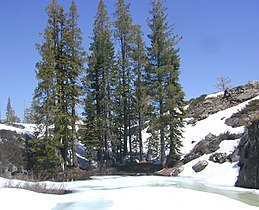Ecology
Appearance
Ecology
A Guide to the Study of Ecosystems
- Introduction to the Guide
- How to use this Guide
- A special note ~ How to contribute
Detailed contents
[edit | edit source]
- Chapter 1 ~ Introduction
- Definition of Ecology
- Scope of Ecology
- History of Ecology
- Chapter 2 ~ Biological Organization
- Basic Definitions
- Units of the Biosphere
- Gaia Theory
- Species and Habitat
Section I – Communities

- Chapter 3 ~ The Abiotic World
- The Physical Environment
- Organism Morphology
- Organism Physiology
- Organism Behavior
- Chapter 4 ~ Biological Communities
- Communities
- Terrestrial Biomes
- Succession
- Limnology
- Chapter 5 ~ Community succession and stability
- Community Stability
- Disturbance
- Problems Determining Stability
- Charles Elton
- Chapter 6 ~ Invasive Species Ecology
- Introduction
- Species status
- Invasive Theories
- Summarization
- Chapter 7 ~ Species Richness and Diversity
- Species Richness and Diversity Introduction
- Rapoport's Rule
- Metabolic Hypothesis
- Diversity Measurements
- Chapter 8 ~ Island Biogeography and Habitat Fragmentation
- Island Biogeography
- Endemism
- Habitat Fragmentation
- Metapopulation Theory
Section II – Populations

- Chapter 9 ~ Species and Populations
- Species Concept
- Population Biology
- Predation
- Chapter 10 ~ Resource Competition
- Population Growth
- Competition Types
- Modeling Interspecific Competition
- Chapter 11 ~ Predation and Herbivory
- Types of Predation
- Herbivory
- Plant Defenses
- Predator-Prey Models
- Chapter 12 ~ Parasitism
- Introduction
- Types of Parasitism
- The Host
- Parasite Community Effects
Section III – Ecosystems

- Chapter 13 ~ Ecosystems
- Introduction
- Ecosystem Concept
- Basic Structural Components
- Characteristics of Esosystems
- Basic Functional Components
- Food Webs
- Chapter 14 ~ Energy in Ecosystems
- Introduction
- Energy
- Organisms Role in the Flow of Energy
- The Laws of Thermodynamics as They Relate to Ecology
- Measuring Energy Flow
- Chapter 15 ~ Biogeochemical Cycles
- Introduction
- Biogeochemical Cycles
- Soil
Section IV – Ecology of the Organism life history examples

- Chapter 16 ~ Manatee
- Chapter 17 ~ Short-Tailed Hawk
- Chapter 18 ~ Peregrine Falcon
- Chapter 19 ~ North American River Otter
- Chapter 20 ~Pinewoods Treefrog
- Chapter 21 ~ Cottonmouth Snake
Section V – Practical Ecology
Appendix A – Glossaries of Ecological Terms
- Glossary 1 – Basic Ecology
- Glossary 2 – Invasive Species
- Glossary 3 – Methodologies
